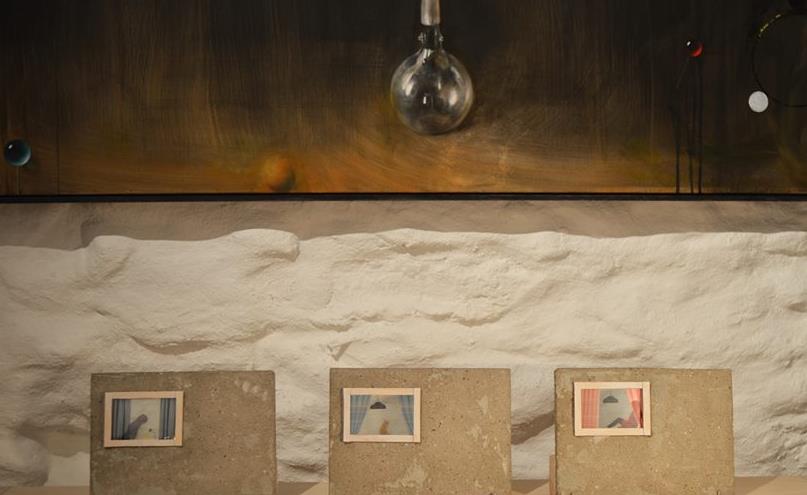Tallinnfilm’s cultic “Glass Cluster Game” must have scared some tender-souled child in its time, who did not yet understand the beauty of the form of the game. Just as glass clusters, livened with the supervision of the artist Kalju Kivi, were compatible with the eclectic and surreal arrangement of the composer Erki-Sven Tüür, they are now compatible with painting. Already for the fifth year in a row, the Estonian Glass Artists’ Union is creating a dialog with the stationary art exposition of Haus Gallery, every work placed on the horizontal flat surface is trying to find a picturesque partner from the vertical wall.
In this way, the tiny glass windows eroded into the tiny concrete slabs are almost looking for support and shelter from Laurentsius’ oil painting hanging above them. The difference of scales is noticeable. In addition, the pastel colour palette of the miniature pictures seems to look pale in front of the deep brown and brightly coloured shiny pellets. What could then make such different forms connect and understand each other? By delving into the dialog, it becomes clear that the round glass container reigning in the middle of the pellets is actually just as fragile as the tiny glass windows, even more that the massive calla flower on the long stalk should have fallen a long time ago according to the rules of physics. The flower in the dark background has a mystical effect similar to the completely everyday yet private scene viewed through the curtains from the windows trimmed into the concrete blocks of the dormitory region. For a moment it feels as if the enormous container could easily be lifted off of the canvas and placed on the miniature window frame, under the lamp shade, to provide company for the light yellow cat.
Similar dialog develops and the mystery continues between the sharpened arrowheads of Caspar Sild and digitally printed homes of the devils of Peeter Laurits. The composition also recalls another Tallinnfilm animation, “Välek Vibulane”. If the glass cluster film talks about ice and fire – the victory of life-giving warmth of the sun over the ever cold nothingness* – then Välek is also fumbling in the dark, searching for the spark that is the basis for life, and brings us into the Stone Age, introducing the living conditions and human relationships of that time*. While Välek’s cave companions were desperately sharpening stone pieces in order to create fire, then the young glass artist sharpened a whole set of translucent arrowheads just as passionately. These arrowheads are now reflecting, just as in the light of a projector, like a symbolic fire place in the smoke hut of the forefather of stone and faith religion, like a fireside of the devils.
But the real glass cluster game starts in the middle of the exhibition hall, where multiple rows of rust, ashy grey and jet black pàte de verre i.e. flakes are lying, which are shaped in the technique of glass glue. Maarja Mäemets’ series “I have a thousand ideas, of which none will be completed,” says everything and nothing at all at the same time. If the flakes have been placed accordingly, they will not create a uniform unit or a specific figure. They cannot be bought or brought home, because they do not have a price in the price list, but at the same time they could be casually placed in one’s pocket, since they are also not fixed on the stand. They are just lying in the middle of the hall amongst all the other works, the contrasting company hanging above the chest of drawers is Mari Roosvalt’s light and lacy painting done in mixed techniques from the series “Nostalgia”.
These are only a few examples of this fragile material, which could be worked into a dangerously sharp and playfully elegant shape at the same time. This material is used to create containers, in which one can hold flowers, and windows, in front of which once can hold containers filled with flowers. Everything else that could be conjured from glass can be seen in the exhibition “Accordance. Ongoing / Going On”, in which a meet and greet with the artists will take place on 20 March.
*the overviews of the animations’ content are from the Estonian Film Database, www.efis.ee
.png)
